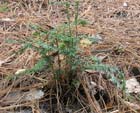Conservation Status

Taxus globosa
Schlectendahl 1838
Common names
Mexican yew; Ciprecillo colorado, Pinabete colorado [Spanish].
Taxonomic notes
Syn: T. baccata subsp. globosa Pilger 1916 (Hartzell 1991).
Description
Trees to 15 m tall and 80 cm DBH, with spreading or ascending branches forming a rounded or irregular crown. Bark reddish turning purple-brown and exfoliating in scales. Twigs slender, angular to round, yellowish to orange turning brown, with bud scales persistent at the base of each year's growth. Leaves in 2 ranks, spreading at 50°-80° from the shoot, mostly linear, slightly curved, 20-30 × 2-2.5mm, concave or with revolute margins, mucronate to cuspidate, leathery, shiny green above and pale green due to two stomatal bands below, with a raised upper midrib from base to mid-leaf, and raised to the tip on the lower side; papillae present on lower midrib (diagnostic characters). Pollen cones axillary, solitary, in rows on either side of fertile shoots, ovoid, 3-4 mm diameter, with 8-12 microsporophylls; cream to pale yellow. Seed cones axillary, solitary on underside of twigs, aril at first green and covering lower half of seed, later orange or red, swollen to cover the seed, globose, 9-12 mm diameter with seed ovoid, slightly flattened, 6-7 × 5-6 mm (Farjon 2010).
The half-length upper midrib is a character distinctive to the New World yews, and the papillae along the lower midrib is a character unique to this species.
Distribution and Ecology
Mexico: Nuevo León, Tamaulipas, San Luis Potosí, Veracruz, Querétaro, Hidalgo, Tlaxcala, Puebla, Oaxaca; Guatemala; Honduras; El Salvador (Hartzell 1991). Found usually at 2000-3000 m elevation in subtropical to tropical cloud forests. In El Salvador and Honduras, limited to elevations above 2500 m, with conifers including Abies guatemalensis and Hesperocyparis lusitanica; in Mexico, cloud forest covers a broader elevation band and broadleaf trees enter the mix, including species of Quercus, Magnolia, Liquidambar, Platanus, Ulmus, Carpinus, Fagus, and Acer as well as the conifers Pinus chiapensis and Podocarpus matudae; at the northern range limits in Nuevo Leon it is an understory tree in Abies-Picea forests (Farjon 2010). Hardy to Zone 8 (cold hardiness limit between -12.1°C and -6.7°C) (Bannister and Neuner 2001).
Distribution data for all species native to the Americas, from Conifers of the World, downloaded on 2018.01.26.
Remarkable Specimens
No data as of 2023.02.23.
Ethnobotany
Since this species contains taxanes, including paclitaxel, it was subject to some exploitation in the mid-1990's, but the market has since moved to plantation-based production (Farjon 2010).
Observations
Although widespread in Mexico, it is nowhere very common. In Oaxaca, it is said to occur along Highway 175 in the vicinity of Ixtlan. In Nuevo León, it has been found in the understory of Picea-Abies forest near La Trinidad at 25° 11'N, 100° 07'W. In Tamaulipas, it occurs in cloud forest of the El Cielo Biosphere Preserve at about 23° 00'N, 99° 15'W, with Acer skutchii, Liquidambar styraciflua, Magnolia tamaulipana, Podocarpus matudae, Pinus sp., and Quercus germanica (R. Nicholson, pers. comm. 2005.05).
I found it (photos on this page) south of El Salto in Nuevo León at 23.9146°N, 99.8018°W, growing in the shady understory of a forest of Abies religiosa and various species of Pinus. The area is readily accessible by a dirt or gravel road, which is in better condition when one approaches the site from the north.
Remarks
The epithet globosa refers to the shape of the immature seed (Farjon 2010).
Citations
See also
The species account at Threatened Conifers of the World.
Nicholson, R. 1992. Death and Taxus. Natural History 101(9): 20-23.
Nicholson, R. 1992. Taxol levels of Taxus globosa, the Mexican Yew [Abstract]. Second National Cancer Institute Workshop on Taxol and Taxus. Alexandria, VA.
Nicholson, R. 1993. Studies of Taxus globosa, the Mexican Yew [Abstract]. International Yew Resources Conference, Berkeley, CA.
Nicholson, R., and D.X. Munn. 2003. Observations on the propagation of Taxus globosa. Bulletin of the Botanical Society of Mexico 72:129-130.
Shemluck, M., R. Nicholson, E. Estrada, and S. Brobst. 2003. A preliminary study of taxane chemistry and natural history of the Mexican yew, Taxus globosa. Bulletin of the Botanical Society of Mexico 72: 119-127.





